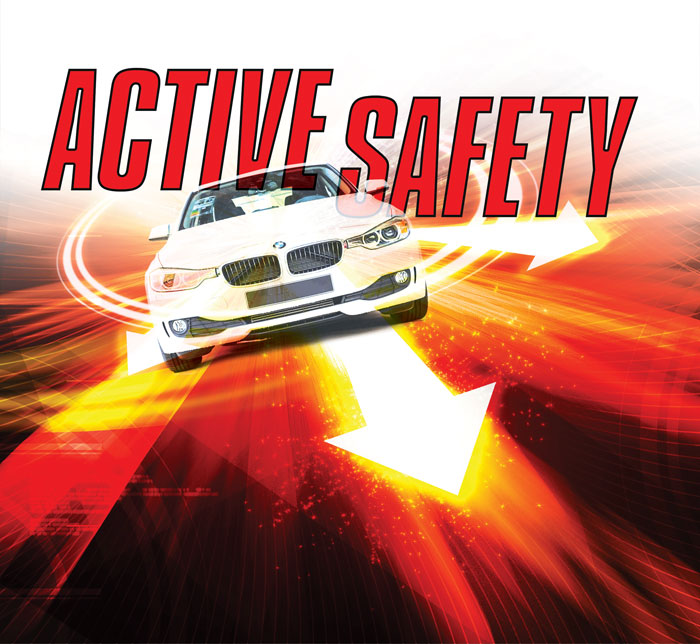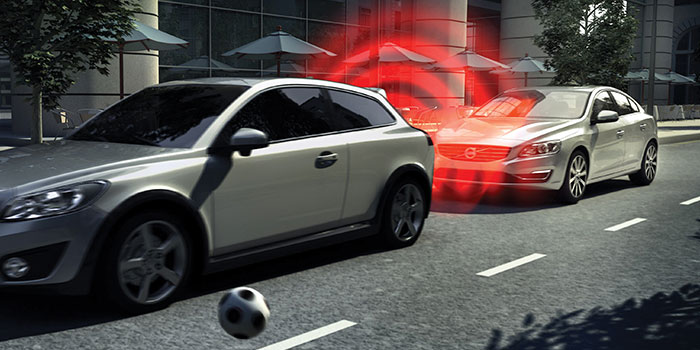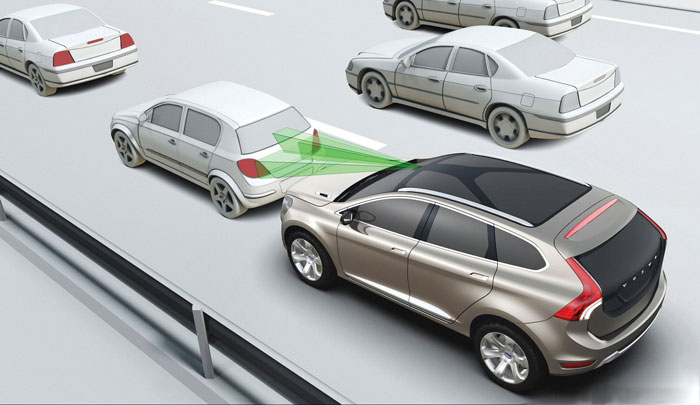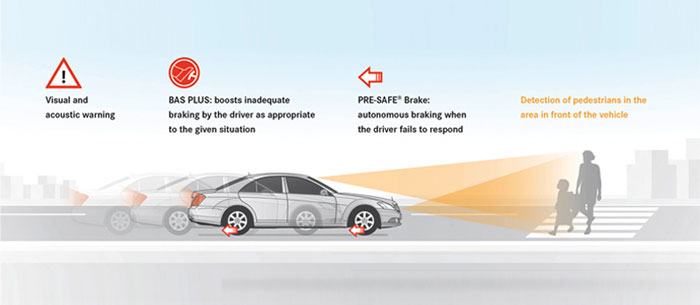 Anything that moves under its own power also has to stop, so brakes have been a safety feature on cars since day one. Over the years, technical innovations such as anti-lock braking systems (ABS) have improved the ability to stop with minimal skidding on wet or slick surfaces. The addition of stability control allowed each wheel to be braked individually to reduce understeer and oversteer when cornering or swerving from one lane to another. Then came braking systems that “precharged” the brakes the instant the driver lifted his/her foot from the accelerator pedal to reduce brake reaction time and stopping distance.
Anything that moves under its own power also has to stop, so brakes have been a safety feature on cars since day one. Over the years, technical innovations such as anti-lock braking systems (ABS) have improved the ability to stop with minimal skidding on wet or slick surfaces. The addition of stability control allowed each wheel to be braked individually to reduce understeer and oversteer when cornering or swerving from one lane to another. Then came braking systems that “precharged” the brakes the instant the driver lifted his/her foot from the accelerator pedal to reduce brake reaction time and stopping distance.
The latest innovation is braking systems that anticipate the need to brake (collision warning) and actually apply the brakes (autonomous braking) to avoid or reduce the damage caused by a collision. These technologies combine elements of “brake assist” with “adaptive cruise control” to take braking safety to the next level.
A growing number of import applications for the U.S. market currently offer some type of automatic braking as standard or optional equipment. These include certain Acura, Audi, BMW, Lexus, Mercedes-Benz, Toyota, Volvo and VW models, plus some Nissan/Infiniti models and the Hyundai Genisys.
The technology is still evolving, so while there are systems that simply warn the driver with a flashing light and/or audible alarm, others warn the driver and actually apply partial braking to slow the vehicle (collision mitigation systems) if the driver fails to react in time, and others actually apply full braking to bring it to a complete halt, depending on the speed and circumstances.
The ongoing evolution in braking technology arises from the fact that tens of thousands of people are killed and injured every year in motor vehicle accidents. In theory, many, if not most, of these accidents could be prevented or reduced in severity by autonomous braking. Although some accidents are weather-related or the result of mechanical failure, the majority of accidents are caused by driving under the influence of alcohol or drugs, driver inattention, driver fatigue or driver error (such as misjudging when to brake and how hard to brake).
Automatic braking is designed to function as a backup co-pilot who is always paying attention, even if the driver is not. It doesn’t assume the responsibility for driving and braking the vehicle (at least not yet), but it can intervene if the driver is distracted or fails to react quickly enough when traffic suddenly slows or stops, or an obstacle appears in the road ahead. An automatic braking system isn’t distracted by any of the things that drivers typically are because it’s constantly monitoring the road ahead.
HOW SAFETY SYSTEMS WORK
Automatic braking systems may use a combination of short- and long-range radar sensors mounted in the bumper or grille to detect what’s going on in front of a vehicle, or Lidar (laser range detection) sensors and/or optical cameras mounted between the rearview mirror and windshield to “see” what’s going on ahead of a vehicle. Radar-based systems will typically sense objects in the road ahead up to a distance of about 80 to 100 yards. Some systems will look farther ahead, up to 200 yards or more, depending on the speed of the vehicle and the maximum speed at which it’s designed to remain active (some systems work only at speeds of 30 to 50 mph or less).
Collision warning systems have been around for a number of years, including those introduced in 2006 on the Acura RL and 2007 Mercedes S-Class and CLS-Class models with “Pre-Safe” braking. These early systems did not apply the brakes, but only warned the driver and precharged the brakes so they would be ready when the driver finally reacted.

One of the first production applications of fully automatic braking was on the 2010 Volvo XC60. Volvo’s “City Safety” system operates only at speeds below 30 km/h (about 18 mph) to prevent low-speed, rear-end collisions and parking lot accidents that account for nearly half of all accidents. The system uses an infrared laser camera mounted behind the windshield to monitor the road ahead. The same camera is also used for adaptive cruise control and lane departure warning.
If the rate of closure indicates a collision is imminent unless the brakes are applied, it will flash a visual warning and sound an alarm. If the driver reacts in time and hits the brakes, the system does not intervene. But if the driver fails to react, it takes over and automatically applies the brakes to stop the car.
The system has its limitations, however. It looks ahead only about 10 meters in front of the vehicle, and avoids a collision only if the relative speed between the car and object is less than 15 km/h. At higher speeds (up to 31 mph), it will slow the car, but not bring it to a complete halt. The system can also be deactivated by the driver, but will revert back to active mode the next time the vehicle is driven.
Since the introduction of the City Safety automatic braking system on the Volvo XC60, accident claims have dropped 20%, compared to comparable vehicles that are not equipped with any type of brake alert or automatic braking system, according to a study by the Insurance Institute for Highway Safety.
On the 2015 Hyundai Genesis, the Automatic Emergency Braking (AEB) system uses both cameras and radar sensors. In fog, rain or other extreme conditions, it can see what’s happening in the road ahead to alert the driver if a crash seems imminent. If the driver does not react, the system will brake automatically and stop the vehicle at speeds of 5 to 50 mph.
On the 2012 Audi A6, a “PreSense” automatic braking system is used. Like the Volvo XC60 system, it will fully brake at speeds up to about 30 km/h in an emergency situation. Above 30 km/h, it will precharge the brakes and apply partial braking as needed to reduce the severity of a collision. It will also tap the brake momentarily to wake up a driver who may be ignoring the visual and audible warnings.
The Audi system uses front-mounted radar and a windshield-mounted camera that sees ahead about 80 meters. It can be switched off by the driver, and will remain off until it’s turned back on by the driver (no automatic reset). The same system is used on certain VW models, and is called “Front Assist.”
The Mercedes “Pre-Safe Braking” system uses radar and precharges the brakes and provides optimal braking assist when the driver applies the brakes. If the driver fails to react, it will apply partial braking to reduce the speed of the vehicle and hopefully mitigate the damage caused by a collision.
The Mercedes “Distronic Plus with Pre-Safe Braking” system combines the features of Pre-Safe braking with adaptive cruise control. Distronic Plus uses short- and long-range radar sensors to monitor traffic conditions up to 600 yards ahead of the vehicle from speeds of 20 to 120 mph. Like Pre-Safe braking, it will partially apply the brakes in an emergency if the driver isn’t paying attention and fails to apply the brakes. On 2014 M-Class SUVs, the system is called “Collision Prevention Assist.”
Most of the automatic braking systems that are currently on the road revert full control to the driver if the driver hits the brakes when a warning is received – which may or may not prevent an accident depending on how fast the vehicle is traveling, how hard the brakes are applied and the distance to the vehicle or object in the road ahead. That’s one of the downsides of current automatic braking systems.
Another drawback is that some systems may apply the brakes autonomously when braking really isn’t necessary, as when the driver suddenly changes lanes and cuts in behind another vehicle. As software and hardware continue to improve, most of these bugs will go away (we hope, anyway), allowing smarter braking and fewer accidents.
Another drawback with automatic braking is that some systems (like on the Volvo XC60) apply full braking only at slow speeds. Systems that use automatic braking with adaptive cruise control can slow a vehicle that’s traveling at highway speeds to maintain safe spacing as traffic slows down and speeds up. But, at highway speeds, it can’t be relied on to fully stop the car if the driver is distracted or asleep at the wheel.
Automakers are very cautious about fully autonomous braking systems for obvious liability reasons. If a car that’s supposed to brake itself doesn’t and hits something, who gets sued? The automaker? The supplier who provided the braking system? The vehicle owner? Or all of the above?
DIAGNOSIS & REPAIR ISSUES
Access to the factory service information is absolutely essential for diagnostics and repair. We searched one online provider of OEM service information for the aftermarket and could not find much service information or any TSBs for 2014-’15 import collision warning or autonomous braking systems.
The information will likely be added as time goes on, but for now you’ll have to go to the OEM service information websites for detailed service procedures. Most of these systems are still under new car warranty and will be for several years, so dealers will likely handle any initial problems and software updates. But, eventually, they will turn up in your shop. When they do, you will need the applicable service information to diagnose and repair them.
Diagnosis also requires using an OEM scan tool or a professional-grade aftermarket scan tool that can access the various safety systems – which means if your scan tool lacks such coverage or is not up to date, you can’t really diagnose these systems.
By intuition, you may be able to figure out where a fault is if there is a warning light and the system is not functioning. Loss of a vital sensor (forward radar or camera, or even a vehicle speed sensor) will affect adaptive cruise control as well as the collision warning and braking system.
A fault within the brake system itself, such as a bad ABS solenoid, pump or relay, or a leaky high-pressure accumulator, may prevent the system from pre-charging or applying the brakes. Electronic faults in control modules and/or wiring may also prevent the system from working normally.
To date, we have not heard of any specific faults or recalls with any of the current applications. This doesn’t mean the technology is working flawlessly or that failures have not occurred, we just haven’t seen any pattern failures to report – yet. However, Volvo has issued software updates for 2011 and 2012 models to reduce the sensitivity of the system after reports of false braking applications in certain driving situations or for “no apparent reason.”
The same factors that affect conventional brakes still apply to automatic braking systems. The pads and rotors need to be in good condition, the brake lines and hydraulics need to be leak-free, and the control electronics (wheel speed sensors, brake pedal switch, ABS solenoids, pump and module) all need to be functioning perfectly. Something as simple as a misadjusted brake pedal switch may upset the operation of the system.
With radar-based systems, mud and snow usually have no effect on the sensors. But with laser- and camera-based optical systems, the optics need a clear view of the road ahead. The windshield wipers should keep the windshield clean, which means if the wipers are not in good condition, they need to be replaced.
Another problem that may be encountered with these systems is that of driver training. A driver may not fully understand how his/her collision warning/automatic braking system is supposed to operate, what it can/can’t do, and what they should/shouldn’t do in an emergency situation.














